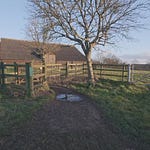All Saints’ Church in Brixworth, Northamptonshire, is one of the most significant examples of early Anglo-Saxon architecture in England. Founded in the late 8th or early 9th century, possibly under the patronage of King Offa or his successor Coenwulf, it originally served as a monastic church.
Constructed in the style of an Early Christian basilica, the church features a clerestoried nave, a presbytery separated by a prominent arch, and the foundations of a semicircular apse. Notably, it was built using reclaimed Roman materials, including stone and brick tiles, likely sourced from the nearby Roman towns of Lactodurum (Towcester) and Ratae Corieltauvorum (Leicester).
Throughout its history, All Saints’ Church underwent several modifications:
• 10th Century: The original two-story porch was elevated to form a west tower, and a stair turret was added.
• 13th Century: A south aisle was appended to the nave, a south chapel was constructed adjacent to the presbytery, and the apsidal chancel was replaced with a rectangular one.
• 14th Century: The west tower received further heightening, culminating in the addition of the current broach spire.
Significant restoration work occurred in 1865–66 under the direction of vicar Charles Frederic Watkins. This project involved removing portions of the medieval chancel and uncovering the subterranean ambulatory that encircled the original apse. Additionally, the southeast chapel was shortened, and the south porch was dismantled to reveal earlier stonework.
Today, All Saints’ Church stands as a testament to early medieval ecclesiastical architecture, reflecting the rich history and architectural evolution of the region.
I visited All Saints back in September last year and filmed it with my Insta360 X3. The music is something I wrote last year.
I’m looking forward to producing more of these during 2025 and beyond. Let me know of the places you’d like to see included here.
I’ll take myself and my 360 camera to film some suggested places.






Share this post